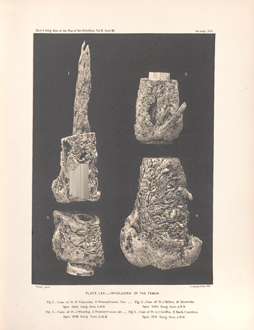Title: Wearing, J.
Source text: The Medical and Surgical History of the War of the Rebellion. (1861-65.), Part 3, Volume 2 (Washington, DC: Government Printing Office, 1883), 224-225.
Civil War Washington ID: med.d2e10685
TEI/XML: med.d2e10685.xml
CASE 437.—Private J. Wearing, Co. L, 2d Pennsylvania Heavy Artillery, aged 20 years, was wounded at Petersburg, June 17, 1864, and admitted to the field hospital of the 1st division, Ninth Corps, where Surgeon M. K. Hogan, U. S. V., recorded: "Wound of left knee joint; amputation at junction of middle and lower third of thigh." One week after the reception of the injury the man was transferred to Finley Hospital, Washington, and in October following he entered Broad and Cherry Streets Hospital, Philadelphia, whence Acting Assistant Surgeon T. C. Brainerd made the following report: "At the date of admission the femur protruded about one-fourth of an inch, and the stump was healed to within one inch of the bone. The patient being anæmic, iron and quinine were administered. Simple dressings were applied to the stump. By November 15th his general health had improved and the line of separation was forming around the protruding portion of the bone. On December 1st, the ulcer upon the stump presented a sloughing tendency, but again cleaned up. On January 6, 1865, about four inches of the extremity of the femur was exsected by cutting down upon it from the outer anterior surface of the stump and sawing through the bone with a chain saw. The bone removed was necrosed and surrounded by a large amount of reparative material. A small artery spouted from the medullary canal of the bone, the hæmorrhage from which was promptly controlled by pressing a piece of soft wax into the canal. Three ligatures were applied and ether was used. The operation was performed by Acting Assistant Surgeon H. M. Bellows. The patient reacted promptly. Simple dressings were continued to the stump. Two days later an attack of erysipelas supervened, extending as for up as the groin, but yielding to treatment, and by January 15th it had entirely disappeared and the general condition had much improved. One month later cicatrization was almost complete, and the patient was walking about with the aid of crutches." In April he was transferred to South Street Hospital, and subsequently to Chester, where he was discharged from service July 26, 1865, and pensioned. Some weeks afterwards the man was supplied with an artificial leg, manufactured by K. Clements. In his application for commutation, dated 1870, he represented the stump as being in a sound and healthy condition. The pensioner was paid June 4, 1879. The sequestrum (Spec. 4196) removed from the stump was contributed to the Museum by the operator, and is represented in FIG. 3 of PLATE LXX, opposite p. 242.
